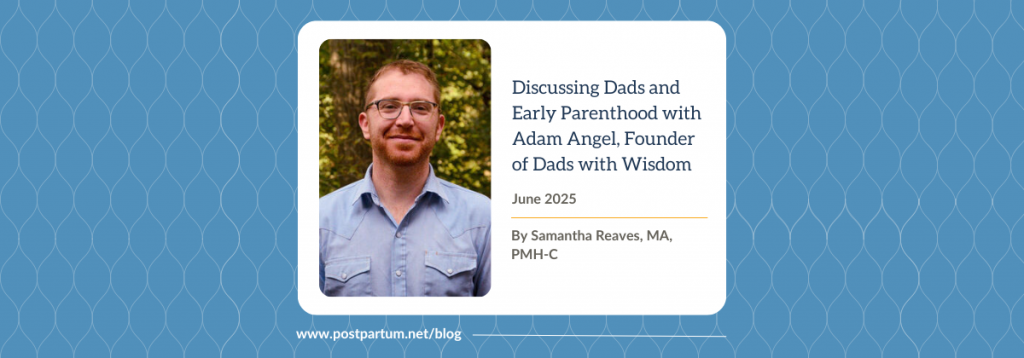A Chat with Author Dr. Rachel Louise Moran
By Samantha Reaves, Communications Specialist, Postpartum Support International

Blue: A History of Postpartum Depression in America is a story of postpartum mental illness in the 20th and 21st centuries and the individuals who have advocated for change.
Tell us about Blue.
In Blue, I wanted to explore how postpartum mental illness went from being largely ignored and dismissed at the beginning of the 20th century, to becoming something much more discussed and understood by the end of that century. For much of the twentieth century, popular and medical voices blamed women who had emotional and mental distress after childbirth for their suffering. By the end of the century, though, women with postpartum mental illnesses sought to take charge of this narrative. Organizations like Postpartum Support International, with the leadership of advocates and clinicians, came to redefine how Americans thought about postpartum illness.
There is of course much more work to be done to support new parents, as PSI members know. But I have been inspired by how much has changed, and by the stories of the individuals behind that change. The book looks at coalitions of maverick psychiatrists, psychologists, and women who themselves had survived substantial postpartum distress, and their fight to legitimize and improve women’s experiences. I used a combination of oral histories and archival research to think through advocates’ motivations, strategies, and wins and losses.
What inspired you to write Blue?
I tell this story in more depth in the book, but basically I was deemed a “high risk” for postpartum mental illness when I was first pregnant. I was discouraged from going off my antidepressant, which at the time I thought was condescending and controlling. Wow, I was so naive! As a historian of health and medicine, I turned to historical questions to make sense of my experience: what were the origins of this screening, of this list of risk factors, etc.? Of course, I soon learned I was unbelievably fortunate to have clinicians who took my mental health seriously, and who understood anything at all about maternal mental health! It was a product of my own whiteness and socio-economic status, plus a lot of luck, that this was my experience. My experience was also the product of decades of women’s activism and advocacy; it would have been unimaginable twenty years before. I wanted to know more about activism and advocacy and think about what has changed and what barriers remain.
Why is it such a critical time to publish this book?
We are at such a pivotal moment around reproductive health politics in the US. I have been fascinated with how perinatal mental illnesses fit, and don’t fit, in the larger schema of those reproductive health politics. In Blue, I wanted to explore how and why the politics of PMADs have been different from those of birth control and abortion. Many women’s health activists struggled to make progress in the conservative 1980s, for example, while that was a time when postpartum depression advocacy made great strides. It has been interesting to think through the contingencies at play there and to consider what parts might be applicable to our current moment.
Your book includes oral histories and archival research. Share with us about some of the people that are featured.
I had the opportunity to speak with many folks who might be familiar to a PSI audience, including Jane Honikman, Wendy Davis, Shoshana Bennett, Susan Dowd Stone, Susan Feingold, Ann Dunnewold, Adrienne Griffen, Joy Burkhard, and many more. Some people I wrote lots about and some less about, but everyone who was kind enough to sit down with me ended up shaping my understanding of changing approaches to perinatal mental illness. This does not necessarily mean they endorse my conclusions, of course! But I am grateful for their openness and generosity. I was also able to use saved materials (cassette recordings of conferences, old brochures, newsletters, news clippings, phone logs, personal letters…) both from formal archives and from individuals’ collections.
Tell us about yourself.
I’m an associate professor of history at the University of North Texas, in Denton, Texas, where I teach classes in US women’s and gender history, medical history, and politics. I earned a PhD in history and women’s studies from Penn State about ten years ago. I am also a mom of three; my kids are 5, 7, and 14 years old.

Who is the intended audience?
Someone who read the book recently told me they want it in the hands of every clinician who works with pregnant and postpartum people, and of course, that would be my dream! I also would love anyone who simply likes history, or wants to think historically about postpartum mental illness, to pick it up. I really worked to make it readable, since I could not stand the idea of these important stories being stuck in some jargony academic tome. Hopefully that comes through.
What do you hope readers of Blue walk away with?
I want readers to appreciate how much has changed in the last 100 years in this area, even though there is still much more to do to support pregnant and postpartum people. And I want them to see how that change has happened. It was not inevitable that postpartum illness would come to be named and recognized, that it would become a specialty for some clinicians, and that there would be legislation addressing it. Change is, instead, the product of the labor of individuals and groups. That is the story I tell in Blue.
Blue is published by the University of Chicago Press and is now available at all major booksellers. You can purchase the book on Amazon or through the Press.
Learn more about the book and Dr. Moran.









